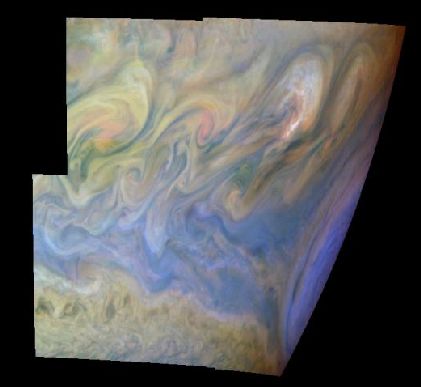Credit & Copyright: The Galileo Project,
NASA
Explanation:
The turbulent region West of Jupiter's Great Red Spot is highlighted in
this recent picture constructed from data recorded by
the Galileo spacecraft.
The image is color coded to show
cloud height and thickness;
white clouds are high and thick, light blue clouds are high and thin, and
reddish clouds are low.
The edge of
the Red Spot itself appears blue here
(lower right) and
spans about 6,600 miles along the curving limb of the planet
(north is up).
Westward winds,
deflected north by the circulation within
the Great Red Spot, collide with
Eastward winds at higher latitudes and generate the roiling, turbulent
structures.
The largest
eddies
near the Northwestern edge of the Red Spot are
bright, suggesting upward convection and high altitude
cloud formation are taking place there.
1999 2000 2001 2002 2003 2004 2005 2006 2007 2008 2009 2010 2011 2012 2013 2014 2015 2016 2017 2018 2019 2020 2021 2022 2023 2024 2025 |
Yanvar' Fevral' Mart Aprel' Mai Iyun' Iyul' Avgust Sentyabr' Oktyabr' Noyabr' Dekabr' |
NASA Web Site Statements, Warnings, and Disclaimers
NASA Official: Jay Norris. Specific rights apply.
A service of: LHEA at NASA / GSFC
& Michigan Tech. U.
|
Publikacii s klyuchevymi slovami:
Jupiter - clouds - Great Red Spot - Bol'shoe Krasnoe Pyatno - Yupiter - oblaka - konvekciya
Publikacii so slovami: Jupiter - clouds - Great Red Spot - Bol'shoe Krasnoe Pyatno - Yupiter - oblaka - konvekciya | |
Sm. takzhe:
Vse publikacii na tu zhe temu >> | |
